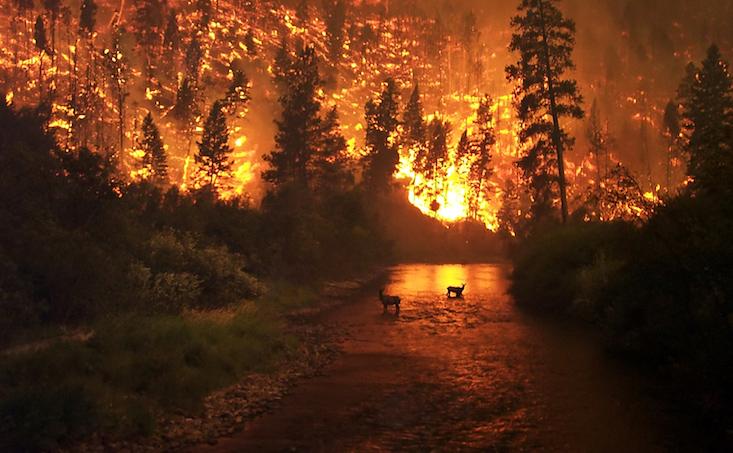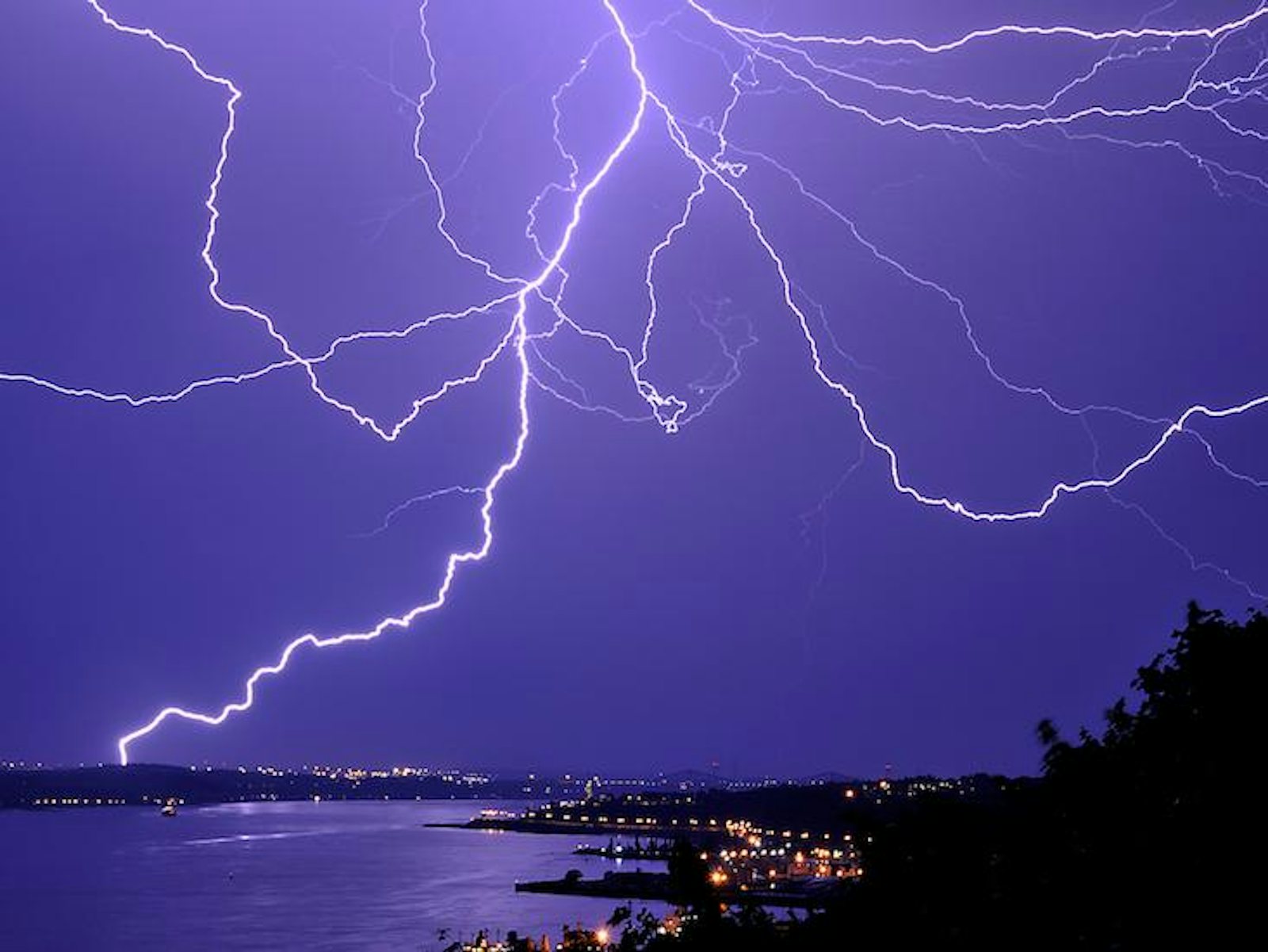Lightning is the flash and rumble of an electron swarm leaping across the sky. With extravagant swiftness it moves through a cloud, from one cloud to another, or between a cloud and the ground, millions of times every day. The role of lightning in the world’s affairs is much more substantial than its ephemerality might suggest. For billions of years it has shaped life on Earth, from the first hidden cells on an otherwise barren planet, to the particular menagerie here today.
Here are five ways lightning has made its mark on life on Earth.
1. Origin of life
Let’s start by setting up a lab experiment. Take a glass container and fill the first quarter or so with warm water, fresh or salted. This is a pond or ocean on the recently solidified primordial Earth. Replace the air above the water with a mixture of carbon dioxide, nitrogen gas, and water vapor. This is the likely composition of the early Earth’s atmosphere. Now discharge electrical sparks through the container, in essence creating miniaturized lightning. (Thunderstorms, as well as volcanic eruptions, ensured lightning was no stranger to the newly minted planet.)
After a series of zaps, analyze the contents of the container. You’ll find a collection of organic compounds, the results of electricity rearranging a small suite of simple gases and water into more intricate forms. Based on similar experiments, researchers at the University of Innsbruck, in Austria, have shown that organics produced by lightning on our nascent planet most likely included amino acids and other fundamental components of living things. These components are thought to have provided a pool of ingredients from which life (self-replicating molecules that organized themselves into cells) came into being and persisted, with all sorts of neat alterations, to the present day.
2. Early Microbes
After single-celled microbes showed up, lightning played a role in keeping them alive and convincing them to figure out how to access nitrogen gas. All living things need nitrogen to make essential molecules like proteins and DNA. Nitrogen gas, which has long been a major component of the Earth’s atmosphere, is extremely stable. As such, it must be transformed into other compounds before nitrogen atoms can be incorporated into cells and tissues. As lightning travels through the sky, it rips apart the triple-bonded atoms of nitrogen gas and welds them onto nearby oxygen atoms to make reactive nitrogen oxides (NO and NO2). These oxides were usable by early microbes, ensuring they had a renewable supply of nitrogen with which to continue reproducing. As microbes spread across the planet and increased in number, supplies of lightning-derived nitrogen oxides declined precipitously. This constraint spurred the evolution of a microbe-controlled internal means of converting nitrogen gas into workable ammonia, permitting efforts toward world domination to continue unabated.
3. Soil Bacteria
Bacteria have since conquered the Earth’s surface, even going so far as to maintain a garrison in both the atmosphere and the deep subsurface. They owe their ubiquity to having collectively evolved an incredibly diverse set of adaptations to deal with the world’s many stresses. This evolution was largely driven by their propensity for acquiring new abilities via mechanisms such as transformation; it involves a bacteria’s cell membrane becoming more permeable, permitting the entry of bits of DNA hanging out in the external milieu. If the DNA contains a useful gene, and everything falls correctly into place within the cell, the bacterium gains a new skill.
We’ve figured out how to coax bacteria into transforming by exposing them to salts or zapping them with electricity, meaning we can intentionally give them new genetic information. In a similar vein, applying an electrical current to a chunk of soil filled with bacteria and bits of DNA can bring about transformation. Using this approach, genes conferring antibiotic resistance have been introduced into bacteria. The bacteria only became antibiotic-resistant after the soil was shocked with laboratory-scale lightning intended to mimic what takes place naturally. Soils are typically filled with bacteria and their DNA, so it’s likely lightning strikes have enhanced the evolution of soil bacterial communities for as long as they’ve been around.
4. Forest Life

Lightning continued to find new ways to exert its influence as life progressed from unicellular to multicellular and from microscopic to macroscopic. As soon as trees appeared, lightning strikes probably began killing them; in addition to scoring direct lethal hits, they are the principal natural means by which wildfires are ignited. Which is good, since dead trees are an important part of forests—they provide homes and food for a plethora of animals and fungi. Bark beetles, for example, are known to seek out lightning-damaged trees to eat.
What’s more, there’s a collection of stationary organisms that reproduce specifically after their neighbourhoods catch fire. Delicious morels and not-so-delicious cup fungi tend to grow their spore-releasing mushrooms from burnt soil and charred wood (you’ll occasionally find them in campfire pits). In forests, fire-linked fungi tend to produce the most mushrooms the year after a fire. Production is triggered when trees the fungi are associated with are damaged by fire and the dead leaves covering the forest floor, from which mushrooms sprout, are burned away. In a matter of life and death, heat and smoke from burning plants can bring about the germination of nearby plant seeds. Some seeds remain impermeable to water until they are exposed to high heat. Once water can get in, the seeds awaken. Seeds can also be stirred to action by karrikins and other growth-regulating molecules in smoke from burning plants.
5. Humanity
Much more recently in the grand scheme of Earth’s existence, lightning has branched out to affect people. We may have diminished its role in global nitrogen chemistry (thanks to Fritz Haber, a Nobel Prize-winning chemist, and the use of fossil fuels) and the initiation of forest fires (poorly handled campfires and unextinguished cigarettes provide some competition), but lightning certainly gets its licks in when it comes to hurting the human body. Every year, a quarter of a million people get to experience being hit by lightning. Providing a conduit through which a powerful electrical current can flow typically results in burns and the disruption of the electrical wiring of the heart and brain. This can be lethal, with people usually dying because their heart stops.

Lightning also has a tendency to brand people in its own image. “Lichtenberg figures,” the result of getting hit by lightning, formed from damaged skin and leaking capillaries, trace the path of electricity across the skin. In addition to injuries and death resulting from being struck, lightning can indirectly inflict damage. One of the more uncommon ways to die is by being hit not by a bolt of lightning but rather pieces of concrete shrapnel thrown into the air when a bolt strikes nearby. More sneakily, lightning can also boost the concentration of ozone in the air around us. (Toss lightning-sourced reactive nitrogen oxides with sunlight, water, and airborne organic compounds, and you get ozone.) Ground level ozone, unlike the helpful ozone sopping up UV rays way up in the stratosphere, causes us harm. It’s irritating, capable of damaging your lungs if you breathe it in. Due to its willingness to disrupt respiration, ozone has a hand in the early deaths of hundreds of thousands of people every year.
When it comes to biology, lightning is an unexpected creator. Electrical currents flowing through the atmosphere can construct an organic toolkit conducive to the genesis of life, produce forms of nitrogen with which the earliest cells could reproduce, and create additional opportunities for these cells and their descendants to gain new genes and evolve. At the same time, lightning is incredibly destructive, as many of the organisms unfortunate enough to get caught in the wrong thunderstorm or wildfire can no longer attest. Though you can blink and miss a single bolt (admittedly, you’ll probably hear it afterward), the constancy of lightning over the history of planet Earth has ensured a key role in its living history.
Chris Drudge is a writer from Canada. He’s interested in biology, history, and public health. Follow him on Twitter @RosinCerate.
The lead photograph is courtesy of Jp Marquis via Wikicommons.






























